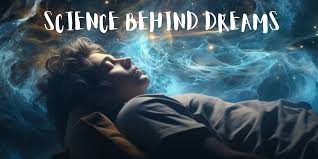Dreams have fascinated humanity for thousands of years. From ancient civilizations interpreting dreams as divine messages to modern psychology viewing them as a window into the unconscious mind, the question persists: Why do we dream? While the exact purpose of dreaming remains a mystery, modern science has uncovered many clues that help us better understand the complex and fascinating nature of dreams.

What Are Dreams?
Dreams are mental experiences that occur during sleep, most vividly during the Rapid Eye Movement (REM) stage. They can include a range of sensations, emotions, thoughts, and images that often seem vivid or even bizarre. People have been trying to make sense of these nighttime narratives for centuries. From Sigmund Freud’s psychoanalytic theories to the most recent neurological research, dreams have been studied from multiple angles.
The Sleep Cycle and Dreaming
To understand why we dream, it’s essential to first understand the stages of sleep. Sleep occurs in cycles, with each cycle lasting about 90 minutes and consisting of the following stages:
- NREM Stage 1 – Light sleep, the transition between wakefulness and sleep.
- NREM Stage 2 – Deeper relaxation and a decrease in body temperature and heart rate.
- NREM Stage 3 – Deep sleep or slow-wave sleep, essential for physical restoration.
- REM Sleep – Brain activity increases, and most vivid dreams occur. Eyes move rapidly, but muscles remain paralyzed to prevent acting out dreams.
REM sleep, which makes up about 20-25% of an adult’s total sleep time, is most closely associated with dreaming. However, dreams can also occur during non-REM stages, though they are typically less vivid and more fragmented.
Theories Behind Why We Dream
Scientists and psychologists have proposed several theories to explain the purpose and function of dreaming. Here are some of the most prominent:
1. The Psychoanalytic Theory
Proposed by Sigmund Freud in the early 20th century, this theory suggests that dreams are expressions of unconscious desires and conflicts. Freud believed that dreams allow us to fulfill our deepest urges in a disguised form. For instance, a dream about climbing a ladder might symbolize ambition or a sexual desire, depending on the context.
Although many of Freud’s ideas have been criticized and debunked, his theory brought attention to the psychological importance of dreams and inspired generations of researchers to explore their meaning.
2. The Activation-Synthesis Hypothesis
This neuroscientific theory, proposed by J. Allan Hobson and Robert McCarley in 1977, argues that dreams are the brain’s way of making sense of random neural activity during REM sleep. According to this model, the brain tries to synthesize this activity into a coherent narrative, which we experience as a dream. In this view, dreams do not necessarily have hidden meanings—they’re simply the brain’s creative attempt to interpret internal signals.
3. The Information-Processing Theory
This theory suggests that dreaming helps the brain process, sort, and store memories from the day. During REM sleep, the brain consolidates learning and experiences, and dreams might be a by-product of this process. This could explain why students often dream about exams or people dream about major life events—they’re reprocessing these experiences.
4. The Threat Simulation Theory
Proposed by Finnish cognitive neuroscientist Antti Revonsuo, this theory posits that dreams evolved as a biological defense mechanism. By simulating threatening situations in dreams, early humans could practice responses to dangers in a safe environment. Although this theory is still debated, some evidence suggests that dreams can help prepare us emotionally and psychologically for real-life challenges.
5. The Emotional Regulation Theory
Some researchers believe dreams help regulate emotions. During REM sleep, the brain processes emotional memories and helps reduce the intensity of negative emotions. Studies have shown that dreaming about traumatic or stressful events can actually help lessen the emotional charge associated with those experiences. In this sense, dreams may act as a form of nocturnal therapy, allowing the brain to work through unresolved issues.

What Happens in the Brain During Dreams?
Advances in brain imaging technology, such as functional magnetic resonance imaging (fMRI) and electroencephalograms (EEGs), have allowed scientists to observe the brain in action during sleep. During REM sleep, several areas of the brain become particularly active:
- Amygdala – Processes emotions, particularly fear and aggression.
- Hippocampus – Involved in memory formation and recall.
- Prefrontal Cortex – Responsible for logic and reasoning; less active during REM, which may explain the illogical nature of dreams.
- Occipital and Temporal Lobes – Related to visual and auditory processing.
This unique pattern of activation explains why dreams often feel emotional, vivid, and surreal. The brain essentially creates a virtual reality experience, drawing on memories, emotions, and sensory input stored in various regions.
Lucid Dreaming: Controlling the Dream World
One particularly intriguing phenomenon is lucid dreaming, where the dreamer becomes aware they are dreaming and can often exert some control over the dream narrative. Studies have shown that lucid dreaming occurs during REM sleep and is associated with increased activity in the prefrontal cortex.
Lucid dreaming has sparked interest not only for its novelty but also for its potential therapeutic applications. Some therapists use lucid dreaming techniques to help people confront fears or cope with recurring nightmares, particularly in cases of post-traumatic stress disorder (PTSD).
Common Dream Themes and Their Possible Meanings
While the content of dreams varies widely, certain themes appear to be universal across cultures and time:
- Falling – Often associated with a loss of control or anxiety.
- Being Chased – Could reflect avoidance or fear in waking life.
- Flying – Often linked to freedom or escaping limitations.
- Being Naked in Public – May represent vulnerability or shame.
- Taking an Exam – Typically tied to self-evaluation or performance anxiety.
While it’s tempting to assign fixed meanings to dream symbols, interpretations are highly subjective and influenced by personal experiences and cultural background.
Do Animals Dream?
The short answer is: yes. Research has shown that many animals, especially mammals like dogs, cats, rats, and even birds, exhibit REM sleep and display behaviors consistent with dreaming. For instance, a sleeping dog might twitch its legs or bark softly, suggesting it’s reliving an experience like chasing a squirrel.
Experiments with rats have demonstrated that they can “replay” experiences during REM sleep, such as navigating a maze. This suggests that dreaming may serve a similar memory consolidation function in animals as it does in humans.
Can We Remember Our Dreams?
Most people forget 90-95% of their dreams within minutes of waking. Dream recall depends on several factors, including:
- The sleep stage at waking – People are more likely to remember dreams if they wake during REM sleep.
- Personality and brain structure – Some individuals are naturally better at remembering dreams.
- Interest and attention – Keeping a dream journal can significantly improve dream recall over time.
Dreams that evoke strong emotions or are particularly bizarre are also more likely to be remembered.
The Future of Dream Research
As neuroscience and artificial intelligence evolve, the study of dreams is entering a new era. Researchers are now working on dream decoding—attempts to reconstruct the content of dreams by analyzing brain activity. While this is still in its infancy, preliminary studies have shown that it’s possible to identify broad categories of dream content, such as whether a person was dreaming about a face or a place.
Moreover, the integration of virtual reality and brain-computer interfaces could eventually allow scientists to induce specific dream scenarios or use dreams as tools for creativity, problem-solving, or emotional healing.

Conclusion: Why Do We Dream?
The question “Why do we dream?” may never have a single, definitive answer. Instead, it is likely that dreams serve multiple overlapping functions—from processing memories and emotions to rehearsing survival scenarios and expressing unconscious thoughts. Whether viewed as meaningless mental static or a profound reflection of our inner world, dreams remain one of the most mysterious and compelling aspects of human experience.
As science continues to peel back the layers of the sleeping mind, our understanding of dreams will only deepen. But until we fully decode their secrets, dreams will continue to captivate, confuse, and inspire us every night.
Read more:https://nfds.xyz/wp-admin/post.php?post=37&action=edit



